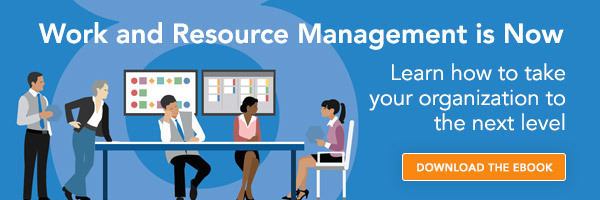
Previously in this series, we covered challenges and obstacles executive and C-level teams face in the world of digital transformation and how to succeed despite any road blocks by selecting the right work and resource management (WRM) technology investments for your organization. For part three, we are going to align those new digital transformation priorities with work and resource management. In case you missed the first two parts, here they are for reference:
- Part 1: An Executive Perspective on Changing Work and Resource Dynamics
- Part 2: An Executive Perspective on the Role of Work and Resource Management Technology
Currently, most organizations continue to use disparate systems that limit collaboration and visibility. Any hesitancy they have in adopting more efficient work and resource management technology stems from a fear of the unknown—many want to stick with the processes they’re used to. However, these processes greatly limit the ability of an organization to compete, especially in this world of digital transformation. You don’t want to risk letting your competition pass you by when it comes to WRM.
Let’s look at how a WRM approach differs from traditional systems and how it aligns with other executive priorities through the following two questions, taken from a Q&A with Ventana Research CEO and Chief Research Officer, Mark Smith.
What makes a work and resource management approach different from what organizations are already utilizing?
As stated above, organizations continue to use disparate systems and personal productivity tools such as email and spreadsheets for work and resource management. However, these tools simply create decentralized silos, resulting in work that is not easily reviewed nor properly aligned to strategy or outcomes. A dedicated and unified WRM approach differs in that it enables every manager and worker to see what needs to be done and what steps are required to achieve projects and tasks—it improves the time to value of all an organization’s work and resources, which is key to fostering both alignment and engagement.
How does work and resource management align with other digital-transformation priorities of executives?
While organizations may be making investments to digitally transform business processes, they aren’t investing in their people and how they work. Executives understand that it’s critical to prioritize investments in digital innovation, but that doesn’t mean they’re acting on it. WRM aligns with the existing priorities of executives as it is an improved and more focused approach to achieving digital transformation.
According to Ventana Research, “embracing WRM means prioritizing digital transformation efforts that will deliver optimal performance while ensuring the investments fully utilize all the resources of the organization.” Once achieved, the organization will be able to:
- Ensure timely and effective management of projects and resources;
- Improve executive decision making about digital investment allocations guided by what can increase engagement of people, regardless of experience or skills;
- Improve both strategic planning of operations and time to market for products and services; and
- Significantly enhance accountability and productivity for the work assigned and the effective use of resources.
Organizations that fail to use their resources in an effective manner risk being left behind by the competition. When people are engaged and resources are optimally utilized, the organization will not only witness measurable improvement in productivity but will also create an environment in which executives can see and review the details of the work management process. Thus, they will be better positioned to evaluate the performance of any programs or strategic initiatives that are designed to improve the value of the organization.
Continue reading the final two parts of this series, in which I will discuss the benefits of WRM and how you can get started.
- Part 4: An Executive Perspective on the Benefits of Work and Resource Management
- Part 5: An Executive Perspective on Getting Started with Work and Resource Management
For more information on work and resource management in the meantime, visit Planview.com.






